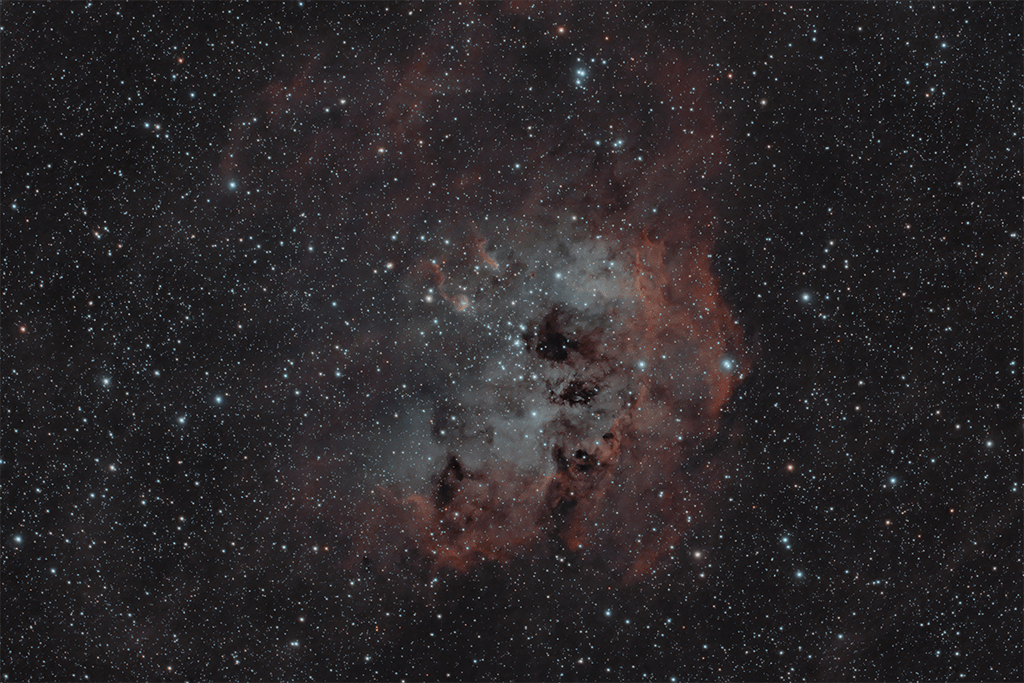
This is a screenshot from Hera Version 0.3, the latest pre-release version of my astrophotography processing software. And this 90-s YouTube video shows how I have used Hera to process an image of the Tadpoles Nebula IC 410 that I captured in November 2021.
For the graphical interface, there is a sequence of steps down the left-hand side, each specifying another step as input with optional blending mask and opacity; each step is an instance of a specific processing tool, the settings of which are editable in the panel on the right-hand side. The output of the selected step is displayed in the center, with its histogram at the bottom. Changing a tool setting in any step automatically propagates through all subsequent steps.
Here is the final image at the end of the video:

About Hera
The design principles of Hera are to:
- offer a range of tools that are specifically suited for processing astrophotos;
- including some of the latest cutting-edge ones from the scientific literature;
- have a fully-editable and re-computable process history;
- be fast, making use of parallel processing and speed-optimized algorithms wherever possible;
- not save large intermediate images, and instead only the ‘sequence’ of steps that gets you to the final processed image (so that means small files);
- have a user-friendly interface.
Tools
Currently available tools include:
- À trous wavelet transform
- Background gradient removal
- Background neutralization
- Color calibration
- Color saturation
- Fast contrast-limited adaptive histogram equalization (CLAHE)
- Cropping
- Histogram transformation
- Iterative masked stretching
- Mask merging
- Morphological transformation (which also does star reduction)
- Fast non-local means (NLM) noise reduction
- Range masking (based on hue, saturation or luminance)
- Star masking (based on the wavelets transform)
- Subtractive chomatic noise reduction (SCNR)
- Unsharp mask
Short-term future development includes (in some kind of order of priority):
- Denoising with deep learning and convolutional neural networks
- Improved narrowband processing
- Color calibration based on catalogued star color
Technical details
Hera is all written in C++. The graphical user interface (GUI) is written in wxWidgets, which means it is cross-compilable for Mac OS X and for Linux/Unix. Image handling is in OpenCV, which mainly just provides the data structures and barely any useful library functions (its 32-bit floating-point capability is dire).
Public release
If there is enough interest, I will offer a basic version of Hera 1.0 for free, and also sell licenses for the full version, probably on an inexpensive annual subscription basis (like SharpCap). I probably won’t be ready for this for about another six months, at least… I keep adding new capabilities! I probably also need to record some instructional videos or write some documentation.
If you are interested in this project, and want to be kept up-to-date, or you are interested in possibly helping with testing at some point in the future, leave a message below.


Currently I am using just PS with extra tools, looking for new additions but not interested to go through a steep Pixinsight learning curve. Never too old to keep on learning, untill Hera caught my eye and subsequent interest.
Would be happy to be kept up to date.
Best regards,
Hans
Hi Hans,
Thanks for the comment. I will let you know when there is a publicly available version to trial.
Hera is still very much in active development. I’ve been working on some AI tools for it over the last few months, including noise reduction (completed) and star masking/removal (based on the StarNet architecture but with my own training datasets). They should be powerful additions. They’re just finicky to get working perfectly and it’s taking some time. I will get there though! And when I do, I think it’ll be time to release it.
Hi Christopher,
Thanks for the speedy reply..
At my age (next week 68) if I would not be patient, something wrong I did in my life. 😉
Rgds,
Hans.